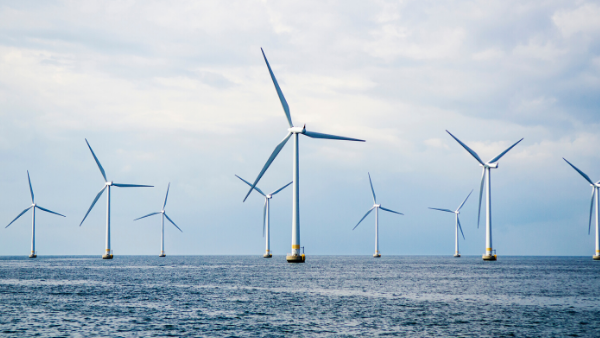Author
This article was first published on LexisNexis on 10/10/2019
Energy analysis: The Crown Estate has released the UK’s first major offshore wind leasing round in a decade. Ian Holyoak, partner at Michelmores LLP, points out that the capacity released is only a quarter of the previous round as the Crown Estate seeks to balance the strong market appetite for new seabed rights with the interests of other seabed users and the potential environmental impact.
Original news
The Crown Estate reveals next round of Offshore Wind Leasing, LNB News 19/09/2019 36
The Crown Estate has launched Offshore Wind Leasing Round 4, which has opened up seabed rights for offshore wind development around England and Wales estimated to allow for the production of at least seven gigawatts of electricity. The Crown Estate, which manages the seabed surrounding England, Wales and Northern Ireland, will now allow potential developers to bid for project sites. The opening of Round 4 follows 18 months of engagement with the market and stakeholders.
What is the Crown Estate Offshore Wind Leasing Round?
The Crown Estate Offshore Wind Leasing Round 4 is the next round of auctions of seabed rights for offshore wind projects in the waters around England and Wales. It is the first opportunity for offshore wind developers to obtain new seabed rights since the last award of rights in 2010 (Leasing Round 3). The Crown Estate has indicated Leasing Round 4 will result in the release of at least 7 GW of new seabed rights, up to a maximum of 8.5 GW.
There are four bidding areas that will be up for grabs in Leasing Round 4:
- ‘Dogger Bank’—off the coast of Northumberland, North Yorkshire and County Durham
- ‘Eastern Regions’—a large area directly south of the Dogger Bank off the coast of Lincolnshire, Norfolk and Suffolk
- ‘South East Region’—off the coasts of East and West Sussex and the south coast of Kent, and
- ‘Northern Wales and Irish Sea’—off the coasts of Northern Wales, Lancashire, Merseyside and southern Cumbria
Within the four areas above, potential bidders will be free to identify and put forward their chosen project sites. The minimum individual project size is 600 MW in the Dogger Bank area, and 400 MW in all other bidding areas, with the maximum individual project size being 1.5 GW in all areas.
Leasing Round 4 will incorporate a three-stage tender process. The first stage will include an evaluation of a potential bidder’s financial capability and technical experience, to ensure bidders meet a minimum required standard. The second stage focuses on the details of a bidder’s proposed projects. Project submissions as a part of the second stage will be assessed on the basis of a number of pre-defined criteria relating to project capacity, project density and other technical variables.
Once through these first two stages, a potential bidder will be able to participate in a multi-cycle bidding process, with the award for each project to be determined by the option fees bid by eligible bidders. One project will be awarded per daily bidding cycle, with bidding cycles continuing until the 7 GW has been awarded (or exceeded). According to The Crown Estate, the process has been designed in this manner to allow for more price transparency, allowing participants to adjust their bidding strategy as the round progresses.
What is the anticipated timeline for the latest leasing round?
The overall leasing process is set to run from October 2019 through each of the stages of the tender process up to signature of an agreement for lease for successful bidders in Autumn 2021.
The first stage for potential bidders, submission of a pre-qualification questionnaire (PQQ), will run for 14 weeks from October 2019 until January 2020. The overall tender process is expected to take approximately 12 months, with a plan-level habitats regulations assessment (HRA) taking a further 12 months.
It is worth noting that the timeline for Leasing Round 4 is not legislatively mandated, so the timelines set out by The Crown Estate should be considered in that context. It is possible that the anticipated timelines will shift as the process progresses.
How does the latest round differ from previous rounds?
The Crown Estate seems to have been at pains to ensure that the design and methodology of Leasing Round 4 has considered the views of a range of stakeholders, given the political and economic context in which this round will take place. The announcement of Leasing Round 4 comes following almost two years of stakeholder consultation, through which several tangible changes were made to the model initially proposed by the Crown Estate in 2017. The model ultimately adopted for Leasing Round 4 is substantially different to Leasing Round 3 and previous rounds.
One key difference in Leasing Round 4 as compared to Leasing Round 3 is the amount of capacity released. While not unexpected, the capacity to be released as a part of Leasing Round 4 represents approximately a quarter of the capacity released under Leasing Round 3. The Crown Estate cited the need to find a balance between the strong market appetite for new seabed rights, the interests of other seabed users, as well as the potential environmental impacts from further offshore wind development. The Crown Estate’s ‘Resource and Constraints for Offshore Wind: Methodology Report’ reveals weight was given to range of factors, including the visibility from shore and the impact on shipping and fishing. Each of these factors had an impact on the location, and ultimately the total capacity, of the rights released as a part of this round.
Perhaps the most notable difference in the latest leasing round is the role of the ‘option fee’. The ‘option fee’ in Leasing Round 4 will act as both the bid at the auction stage, as well being one of the bases upon which the base rent under a lease for a project is to be calculated (at both pre-generation and operational stages). In contrast, the revenue model adopted for projects awarded under Leasing Round 3 was based on a percentage of the revenue generated by a project. The latest model accordingly shifts a certain amount of development and generation risk back to the developers and funders on each project, particularly during development stages.
On a similar theme, Leasing Round 4 will also not incorporate the co-investment aspects seen in Leasing Round 3, whereby the Crown Estate invested directly by funding a proportion of a developer’s consenting costs. Assistance from Crown Estate in the new Leasing Round comes in the form of study and feasibility support, information collation and ‘enabling’ works packages. The Crown Estate’s guidance document indicates ongoing engagement and facilitation will be available to successful bidders, particularly in relation to consenting and environmental impacts. The latter will be of particular note, given the recent progression of the 2017 Extension projects through the HRA to the rights award stage.
Is there anything unexpected?
As with any energy generation projects, the availability and location of cabling and grid connections are crucial to the viability of a project. The Crown Estate identified concerns around cabling and grid connections as a key feature of stakeholder feedback during the consultation process leading up to the latest leasing round. This remains one of the key unknowns in the Round 4 process.
The underlying regulatory basis for offshore transmission is, of course, well understood by the market and it will apply equally to the projects developed as a part of Leasing Round 4. The transmission infrastructure will be developed by the developer of the windfarm and then transferred to an Offshore Transmission Owner (OFTO) which will either be selected through a competitive tender process or directly appointed by Ofgem.
However, the feedback to the consultation raised a number of questions that the Crown Estate has been unable to address head-on, and which are unlikely to be resolved prior to the bidding stage of the process. In particular, whether transmission could be accommodated within existing transmission routes (where the bidding area abuts already developed seabed), and how future development of grid infrastructure may impact grid connection availability in constrained landfall areas (for example within Suffolk). On the latter point, the Crown Estate has revealed that when designing the amount of capacity that will be allowed in any region, it did not explicitly take into consideration the findings of the National Grid’s Electricity System Operator (ESO) desktop connection feasibility study, which assessed grid connection and possible cable routes for the regions. Developers will, accordingly, need to make use of the resources provided by the Crown Estate and undertake their own assessments of the financial viability and consent risk for potential cable routes and grid connection locations prior to submitting bids.
Notwithstanding these points, in the main, given the long and detailed consultation process undertaken, there are few surprises in the documentation released by the Crown Estate launching Leasing Round 4. It broadly aligns with the previous documentation released and many stakeholders are likely to have already begun progressing internal planning for these projects.
What potential implications does it have for the UK energy sector?
The launch of Leasing Round 4 appears to have been received positively by the majority of stakeholders in the energy sector and, unsurprisingly, particularly by those engaged in or seeking to engage within the renewables sector. Offshore wind is a key feature of the government’s future plans for decarbonisation of the UK energy supply chain and it seems likely that the private sector will be similarly enthusiastic about investing in the technology through Leasing Round 4. The strong government support will no doubt be viewed favourably in contrast to what is seen as a general cooling in government support for renewable energy development on a wider level, most notably in the area of small-scale generation.
The energy supply chain and the local energy sector business in the areas from which these projects will be constructed and serviced will naturally also benefit from both the construction and operation of the offshore windfarms as a result of the development of rights released under this latest leasing round. From the perspective of UK energy security and job creation, there would appear to be little to complain about in the announcement of Leasing Round 4.
Assuming the round is a success—and there is no reason to suggest otherwise given the success of past rounds—it is also likely to add to the narrative of offshore wind being seen as a ‘thermal generation killer’. Coming at the same time as historically low prices seen in the most recent Contract for Difference (CfD) auction round for offshore wind, Leasing Round 4 may add weight to arguments against new government-supported developments of non-renewable forms of electricity generation. Ever the punchbag in the renewables sector, Hinkley Point C will undoubtedly continue to receive its share of criticism, as proponents point to the Crown Estate’s ambition to deliver future leasing opportunities in line with market and government appetite. However, the need for baseline generation and technological advances to address the inherent volatility of wind generation will remain.
Holyoak was interviewed by Grania Langdon-Down of LexisNexis.
The views expressed by our Legal Analysis interviewees are not necessarily those of the proprietor.
The Michelmores Energy Team has significant experience advising on the financing, development and sale/purchase of wind projects. If you or your company would like any further information, please contact Ian Holyoak.
Print article

